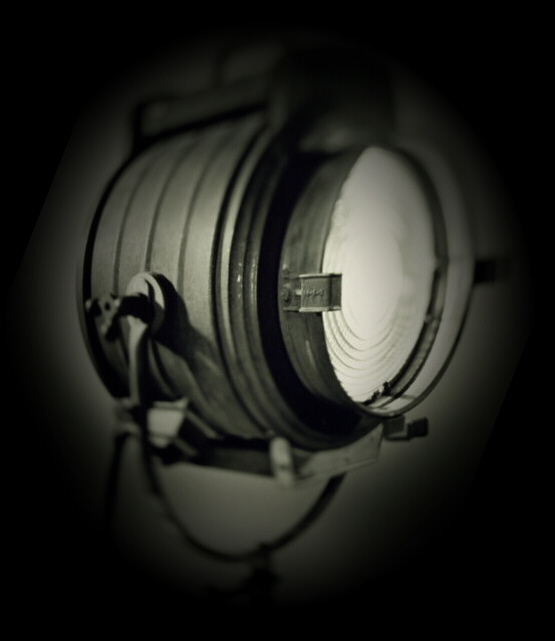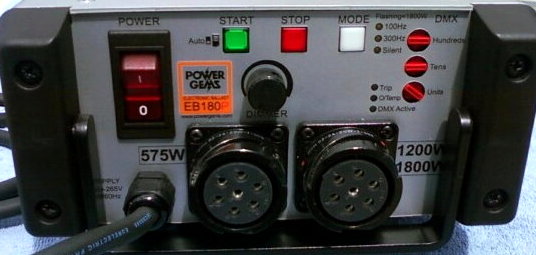
FLICKER FREE HMI LIGHTING REPAIR SINCE 1989.
MOTION PICTURE - TELEVISION - VIDEO
Tech Tips

by Galaxy Repair Service Tech Support
.
![]() Main Problems with HMI’s; Light Flutters, Flickers or Light Shuts Off.
Main Problems with HMI’s; Light Flutters, Flickers or Light Shuts Off.
Light Flutter or Flicker
60% of light flutter or flicker is caused by a bad lamp (bulb, globe); it could be too old (to many hours, main problem), defective or damaged (even if it is new). An old lamp could also overheat your ballast, draws more power and of course it will change your color temperature. So before you send your ballast or head in for repair, change your lamp to see if your problem goes away. Light Flutter or Flicker with a Video Camera can also be caused by the actual frequency (50Hz to 75Hz) of the light output when you shoot, for example, at a shutter speed of 1/500 f/2.8 or 1/2000 sec at a frame rate of 30fps. You can eliminate this problem by using a higher output frequency electronic ballast (100Hz or higher, 300Hz would be the best). The picture below shows a Power Gems 575/1200/1800w Power Factor Corrected HMI Electronic Ballast that operates at 300Hz output, which is great for any high speed Video or Film. (Click on the picture to enlarge)
20% of light flutter or flicker is caused by bad power or a faulty power connection; it could be at your power source or head feeder from your ballast to your head. You can check your head feeder connections at the end of each connector (at strain relief) to see if it is getting hot by feeling it after the head has been running for about 5 to 10 minutes or when you see your light flutter or flicker. The Lamp socket or lamp holder can also create a problem if it has a loose connection, check for discoloration on the metal male pins of the lamp and/ or the female pins on the lamp socket or lamp holder. If you are using a magnetic ballast you can also check your AC power source with a meter to make sure your power is not fluctuating. Remember that with a magnetic ballast, whatever power (voltage) goes in to the ballast (stable or not) also comes out of the ballast to the light, another words, if your input power fluctuates your light will fluctuate (flutter or flicker).
Light Shuts Off or Flutters / Flickers using an Electronic Ballast with a Generator.
If you are using a none Power Factor Corrected Electronic Ballast, such as a Desisti, CMC or Lightmaker Ballast, your generator must be 2x the output power of the ballast you are using to be safe. A 4k Lightmaker Electronic Ballast will run 48 to 56 amps (depending on the age of the lamp) at 120vac input. For example: If you are using a 2.5/4K Lightmaker Electronic Ballast and you are using a 4000w Head, your generator must be at least 8000 watts to work properly. So, if you are using 2 4k heads, you need a 16KW minimum generator to work properly. You need to do this so the power of the generator maintains the power need for the ballast to maintain a good clean output power Square Wave to the Light, if you use a wrong size generator the Square Wave to the head starts to deform and causes Flutter/ Flicker and can even cause the light to shut down. If you continue to try to re-strike the light over and over, it will damage the ballast and it will be a very expensive repair, a very common problem. In a non-power factor corrected ballast you need that much more power to maintain the load output square wave to give you a flicker free light output. If you are using a Power Factor Correction ballast such as a Power Gems, Power to Light or Arri ballast, you can multiply x 1.15 to be safe. You do not need a Crystal Sync Generator to run an Electronic Ballast, but you do need it to run a Magnetic Ballast.
NOTE for 200w S/E HMI's: The 200w S/E lamp for the 200w Fixture has two different size pins (one larger than the other), so you have to make sure that the lamp male pins align correctly to the socket female pins. Failure to do this will cause the larger male pin forced into the smaller female pin and the smaller male pin loose on the larger female causing a bad connection (loose not tight). Also, failure to do this will cause flicker/ flutter, light to shut off or even damage to the electronic igniter and lamp in the head by trying to self ignite over and over due to the poor contact on the reverse loose pin causing the igniter to go bad. This will lead to a very expensive repair.
.
Galaxy Repair Service Lamp Choice:
Best HMI Lamps; Osram / Philips / Wolfram
Worst HMI Lamps; Koto / GE (800w, 4kw, 6kw, 12kw & 18kw)
Main Problems with Tungsten Lighting.
Overheating at plug, switch or socket causing opens or intermittent opens, and always check your lamp.
Main Problems with Fluorescent Lighting.
Damaged internal individual boards caused by dropping or banging ballast, treat your ballast like you treat your cell phone. Flickering can be caused by bad lamp socket connections (not seated properly), or burnt socket. Any damage or burnt out components caused to the internal ballast(s) would need to be repaired by a repair center (Galaxy Repair Service).
Why does the Lightmaker Electronic Ballast have such a bad reputation?
The Lightmaker name has been given a bad reputation due to the physical abuse almost from the very beginning (from when it was first manufactured), mainly by renters from Rental Houses who continually mistreated the equipment simply because it did not belonged to them. Since the Lightmaker is a Solid-State Electronic Ballast and does not have a great input or output power protection, any mistreatment of the ballast, such as dropping or banging of the unit would cause internal damage creating extensive damage when trying to use the ballast. One of the reasons (when electronic ballasts were first introduced) was because most of the people in the industry were using magnetic ballasts with the same type of abuse treatment. A magnetic ballast is like a tank (iron and copper) which could take more abuse because it does not have solid-state electronics, like the Lightmaker ballast. The education for the change from magnetic to electronic ballasts was never there. Since the Lightmaker ballast was one of the first Flicker-Free HMI Electronic Ballasts in the Entertainment Industry, everyone treated the Lightmaker ballast like a Magnetic ballast. This was like treating your cell phone like a basketball. The Lightmaker ballast has been used, and still is, by many popular Studios such as Warner Bros., Paramount, Universal, 20th Century, Sony, Raleigh Studios and many others with great success. So remember no matter what Brand of Electronic Ballast you use, treat it like you would your cell phone (a big cell phone!), with great care! and always remember; " a magnetic ballast is like a tank, but an electronic ballast is like a BMW " gn
Note: Remember that the Dimmer Control on the older AC/DC Lightmaker Electronic Ballasts (Model II) controls the color temperature. So when you turn it clock wise (thinking you are turning up the brightness), you are actually dimming the brightness (footcandle) down and bringing the color temperature up, so to get full brightness you need to turn it counter-clock wise. A lot of people do not know this, so they end up miss-using the ballast by not getting the full output power (1200w) to the lamp and ending up with the wrong color temperature (sometimes over 9000 Kelvin).
Fact: Many people do not know that the Lightmaker Ballast received a Technical Achievement Award from the Academy of Motion Picture Arts & Sciences (A.M.P.A.S.) for the development of the Lightmaker HMI Flicker Free Electronic Ballast. They have also received an Outstanding Achievement in Engineering Award from the Television Academy of Arts & Sciences (T.A.A.S.) in 1991.
.





